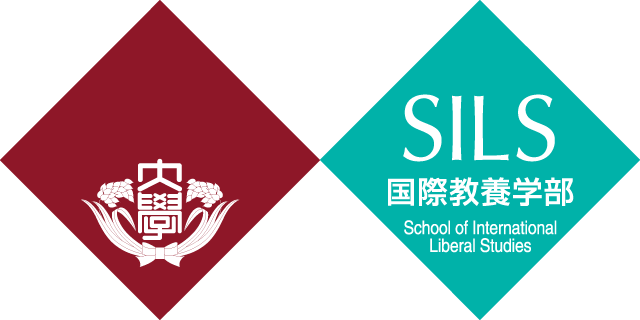- About the School
- Curriculum
Curriculum

SILS Three-Stage Curriculum
Today’s international community needs individuals with a unique skill set: cross-culturally competent, with a big-picture view of society, an ability to independently define the issues facing the world, and the leadership necessary to implement solutions. SILS is working to develop just these multifaceted individuals, who are capable of producing beyond borders, in virtually any field of endeavor. With this in mind, the school eschews specialization and builds on the generalist roots of a strong liberal education. In addition to its year-long study abroad program, SILS offers a robust, wide-ranging general education, designed to cultivate a multidimensional outlook, logical thinking abilities, high ethical awareness, international sensibility and superior language skills.
The four-year SILS course of study consists of spring and fall sessions each year, eight semesters in all.
| 1st Year | 2nd Year | 3rd Year | 4th Year | |||||
|---|---|---|---|---|---|---|---|---|
| 1st Semester | 2nd Semester | 3rd Semester | 4th Semester | 5th Semester | 6th Semester | 7th Semester | 8th Semester | |
| Study Themes | Developing Basic Study Themes | Studying Abroad (Optional) | In-depth Research in Selected Areas | |||||
| Students select introductory courses in a variety of fields, exploring general interests rather than specialized areas, and discovering the educational themes they wish to research in more depth. At this stage students learn techniques of English academic composition in depth, in parallel with their work on Japanese language acquisition. The early curriculum also focuses on the study of statistics, fundamental to contemporary literacy. | Students may choose to continue their education at Waseda University, or spend this year studying abroad. In either event, the courses they pursue at this time will form the basis for more specialized learning from the seventh semester forward. | Students take advanced classes and seminars. Building on their studies to this point, they develop greater awareness of issues in fields of personal interest and research these areas more intensely and in greater depth. | ||||||
Note
The table for Study Plan 2 (for native speakers of languages other than Japanese) is based on September admission. For students admitted in April, Semester 4 and Semester 5 comprise the one-year study abroad period.
Two Study Plans
- Based on the Student’s Native Language
SILS curriculm divided into two study plans depending on their language proficiency; <Study Plan 1> for students whose first language is Japanese and <Study Plan 2> for students whose first language is not Japanese. As a rule, the medium of instruction is English and the same courses are offered to both Study Plans except for the differences mentioned below.
Definition of Study Plans
| Study Plan 1 | Study Plan 2 | |
|---|---|---|
| Definition |
|
|
| Curriculum |
|
|
| One-Year Study Abroad | Mandatory | Optional |
Study Plan 2
Curriculum Designed for Native Speakers of Languages Other than Japanese
Study Plan 2 (SP2) is based on a curriculum geared to students whose first language is not Japanese. Operating from the premise that most incoming students cannot yet sufficiently communicate using the Japanese language, SP2 gives learners the opportunity to master Japanese from whatever level they begin, at the same time they are progressing with their regular English coursework. By graduation, the program has effectively guided participants to fluency in conversational Japanese, as well as sufficient written composition, reading and listening comprehension skills. The SP2 Japanese program also includes support for students pursuing Level 1 certification in the Japanese Language Proficiency Test and/or employment in Japan.
Credits earned by an SP2 student (native speaker of a language other than Japanese) enrolled in September
| Category | Fundamental Courses | Specialized Courses | Electives | |||
|---|---|---|---|---|---|---|
| 35 credits | 56 credits | 33 credits | ||||
| Type | Language Courses |
Statistics | Data Science* | Seminars | Lectures | Fundamental Courses |
| Courses | Japanese | Introductory Statistics |
Introductory Data Science |
1st Year Seminar |
Introductory Courses |
Specialized
Courses |
| English | Intermediate Seminar |
Intermediate Courses |
Open Courses | |||
| Other Foreign Languages | Advanced Seminar |
Advanced Courses |
Courses of Other Departments | |||
| Directed Studies for Senior Thesis |
Courses Taken during Overseas Study Program | |||||
| Credits | 31 | 2 | 2 | 16 | 40 | 33 |
| Credit Requirement for Graduation 124 credits *For those entered SILS in 2025 and beyond, Data Science is one of the required categories in the graduation requirements. |
||||||
Study Plan 1
Curriculum Designed for Native Speakers of Japanese
Rigorous coursework and a year studying abroad develop internationally competitive individuals qualified to take on the world Study Plan 1 (SP1) is based on a curriculum developed for students whose first language is Japanese. Since SILS educational goals include fostering individuals with the ability to think logically, present persuasively, and compete on the international stage, the SP1 curriculum features a program to bolster students’ English skills, enhance their capability to absorb knowledge from the latest overseas literature and communicate at a world-class level. In addition, SP1 students are generally required to spend a year studying outside Japan.
Credits earned by an SP1 student (native Japanese speaker) enrolled in April
| Category | Fundamental Courses | Specialized Courses | Electives | |||
|---|---|---|---|---|---|---|
| 19 credits | 60 credits | 45 credits | ||||
| Type | Language Courses |
Statistics | Data Science* | Seminars | Lectures | Fundamental Courses |
| Courses | English | Introductory Statistics |
Introductory Data Science |
1st Year Seminar |
Introductory Courses |
Specialized Courses |
| Other Foreign Languages |
Intermediate Seminar |
Intermediate Courses |
Overseas Study Preparatory Course |
|||
| Advanced Seminar |
Advanced Courses |
Open Courses | ||||
| Directed Studies for Senior Thesis |
Courses of Other Departments | |||||
| Courses Taken during Overseas Study Program | ||||||
| Credits | 15 | 2 | 2 | 20 | 40 | 45 |
| Credit Requirement for Graduation 124 credits *For those entered SILS in 2025 and beyond, Data Science is one of the required categories in the graduation requirements. |
||||||
Four-Year Study Plan
Four-year study plan for an SP1 student
| Classification | No. of credits necessary for graduation | 1st year | 2nd year | 3rd year | 4th year | |||||
|---|---|---|---|---|---|---|---|---|---|---|
| 1st sem. | 2nd sem. | 3rd sem. | 4th sem. | 5th sem. | 6th sem. | 7th sem. | 8th sem. | |||
| Language | English Ⅰ Reading | 2 | 1 | 1 | ||||||
| English Ⅰ Listening | 2 | 1 | 1 | |||||||
| English Ⅱ | 4 | 2 | 2 | |||||||
| English Ⅲ Level 1~3 | 3 | 2 | 1 | |||||||
| Other Foreign Languages | 4 | 4 | ||||||||
| Seminar | First Seminar Ⅰ A・B | 4 | 2×2 | |||||||
| First Seminar Ⅱ A・B | 4 | 2×2 | ||||||||
| Intermediate Seminar | 2 | 2 | ||||||||
| Advanced Seminar/ Directed Studies for Senior Thesis(*1) |
10 | 2 | 2 | 2 4 |
||||||
| Statistics | Introductory Statistics | 2 | 2 | |||||||
| Data Science(*2) | Introductory Data Science | 2 | 2 | |||||||
| Lecture | Introductory | 8 | 8 | |||||||
| Intermediate | 16 | 16 | ||||||||
| Advanced | 16 | 16 | ||||||||
| Elective | Elective | 45 | 45(including credits earned during your stay at a university overseas) | |||||||
| Total(Standard) | 124 | (17) | (17) | (16) | (28) | (16) | (16) | (14) | ||
| Maximum allowable number of credits(*3) | 21 | 21 | 20 | 20 | 20 | 20 | 20 | 20 | ||
*The above chart is a model. As long as you fulfill the graduation requirements, you do not have to follow the above chart.
*1)”Advanced Seminar” and “Directed Studies for Senior Thesis” are not compulsory courses.
*2)For those entered SILS in 2025 and beyond, Data Science is one of the required categories in the graduation requirement.
*3)Credits of voluntary courses are not included.
If you study abroad program ends in your 6th semester or if you have applied for early graduation, the semester you should start taking Advanced Seminar and the number of semesters you should take it, will be different.
Four-year study plan for an SP2 student
| Classification | No. of credits necessary for graduation | 1st year | 2nd year | 3rd year | 4th year | |||||
|---|---|---|---|---|---|---|---|---|---|---|
| 1st sem. | 2nd sem. | 3rd sem. | 4th sem. | 5th sem. | 6th sem. | 7th sem. | 8th sem. | |||
| Language | Japanese | 24 | 6 | 6 | 6 | 6 | ||||
| English Ⅲ | 3 | 2 | 1 | |||||||
| Other Foreign Languages | 4 | 4 | ||||||||
| Seminar | First Seminar Ⅰ | 2 | 2 | |||||||
| First Seminar Ⅱ | 2 | 2 | ||||||||
| Intermediate Seminar | 2 | 2 | ||||||||
| Advanced Seminar/ Directed Studies for Senior Thesis(*1) |
10 | 2 | 2 | 2 4 |
||||||
| Statistics | Introductory Statistics | 2 | 2 | |||||||
| Data Science(*2) | Introductory Data Science | 2 | 2 | |||||||
| Lecture | Introductory | 8 | 8 | |||||||
| Intermediate | 16 | 16 | ||||||||
| Advanced | 16 | 16 | ||||||||
| Elective | Elective | 33 | 33(including credits earned during your stay at a university overseas) | |||||||
| Total(Standard) | 124 | (17) | (17) | (16) | (16) | (28) | (16) | (14) | ||
| Maximum allowable number of credits(*3) | 21 | 21 | 20 | 20 | 20 | 20 | 20 | 20 | ||
*The above chart is a model. As long as you fulfill the graduation requirements, you do not have to follow the above chart.
*1)”Advanced Seminar” and “Directed Studies for Senior Thesis” are not compulsory courses.
*2)For those entered SILS in 2025 and beyond, Data Science is one of the required categories in the graduation requirement.
*3)Credits of voluntary courses are not included.
If you study abroad program ends in your 6th semester or if you have applied for early graduation, the semester you should start taking Advanced Seminar and the number of semesters you should take it, will be different.
